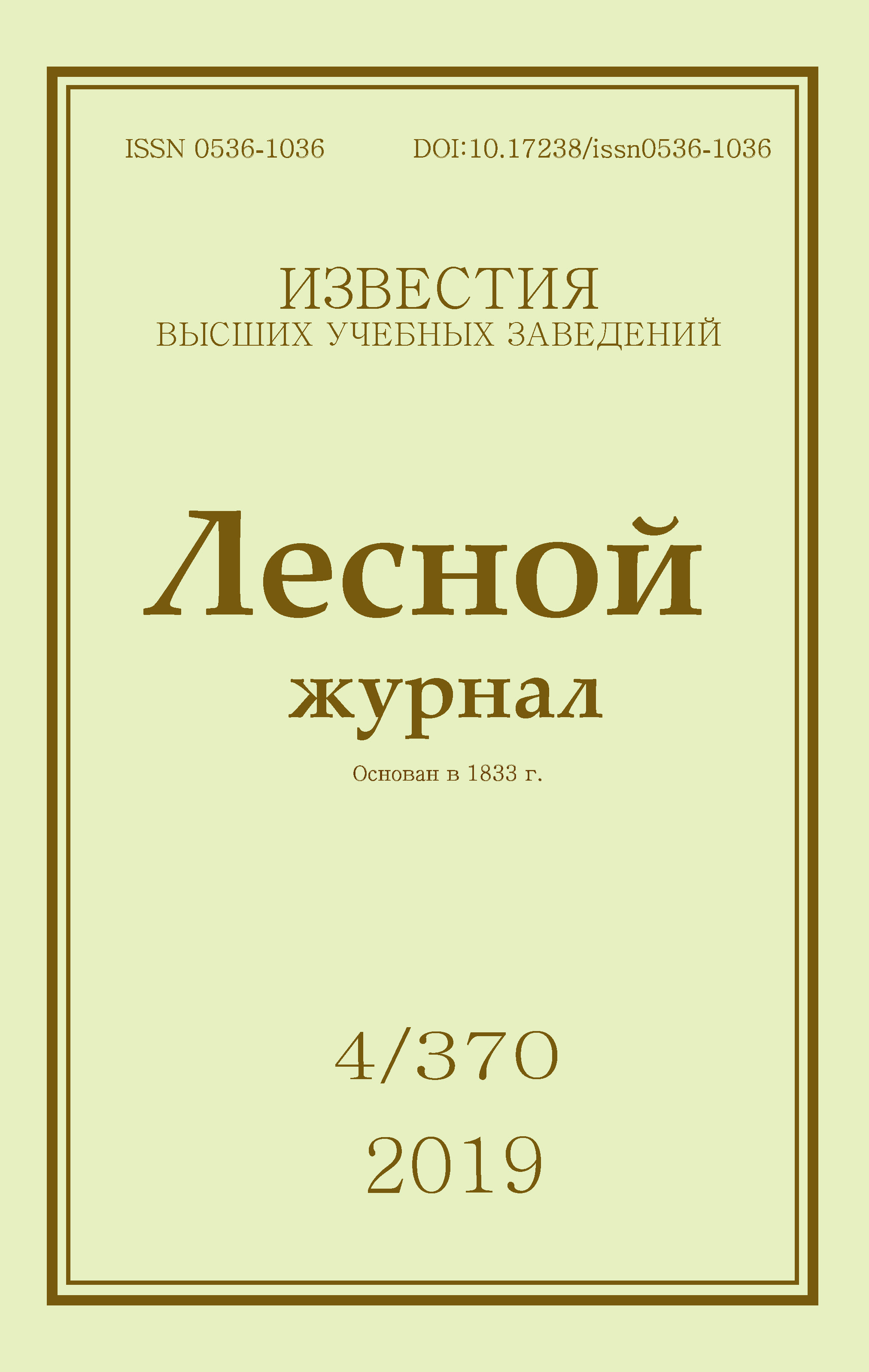Mycological Investigation of a Wood Substance of Historic Cultural Heritage
DOI:
https://doi.org/10.17238/issn0536-1036.2019.4.212Keywords:
wooden Anglican church, on-site investigation, mycological researches of biodestructive microorganisms, determination of durability of wood substance, restoration worksAbstract
The wooden Anglican church developed in Arkhangelsk in 1837 is now a regional site of cultural heritage. The main objective of the present research was to investigate the wood substance of the building elements in order to define their durability and mycological vulnerability. The performed examination revealed that the durability of some wooden components and details of the monument gives cause for concern. The wood substance of those details was investigated by the method of quantitative definition of the viable disrupting spores of fungi per 1 cm2 and number of colony-forming microorganisms per 1 g of a test mass. Durability of the wood substance was determined in accordance with GOST 16483.11-72 and GOST 16483.10-72. The objects of the mycological researches were: the crib works (main, northern and lateral facades); the basement; the roof; the window framings. The taxonomical accessory of the allocated strains of microorganisms was determined. As a result of mycological investigation, the biodeteriorating fungi of Trichoderma viride, Trichoderma koningii, Fusarium solani and Alternaria alternata were discovered. Detection of the actinomycetes, yeast-like fungi and bacteria confirmed the fungi spores viability. Destructive wood fungi were not found. As a result of determination of wood durability dependence on quantity of the viable spores it is verified that significant destructions of wood substance begins at concentration level more than 100 spore/cm2. The presented samples of wood have indicated the mycological stability and durability. During usage of the old and new timber for restoration works, obligatory treatment with the protective agents actively suppressing development of all species of microorganisms, including wood-destructive and mold fungi is recommended. The results of the examination of the wooden Anglican church indicate that combination of on-site and mycological investigations of components of a monument enables preservation of historical monuments for long term.
For citation: Pokrovskaya E.N., Agapov D.V., Kovalchuk Yu.L. Mycological Investigation of a Wood Substance of Historic Cultural Heritage // Lesnoy Zhurnal [Forestry Journal], 2019, no. 4, pp. 212–220. DOI: 10.17238/issn0536-1036.2019.4.212
*The article was published in the framework of implementation the development program of scientific journals in 2019.
Downloads
References
Билай В.И., Коваль Э.З. Аспергиллы. Киев: Наук. думка, 1988. 204 с.
Биоповреждения и биокоррозия в строительстве // Материалы междунар. науч.-техн. конф. Саранск: Изд-во Мордовского ун-та, 2004. 255 с.
Ванин С.И. Домовые грибы, их биология, диагностика и меры борьбы. Л.: Кубуч, 1931. 112 с.
Вахрамеева Т.И., Вахрамеев Е.В., Любимцев А.Э. Обследование и подготовка проектной документации на противоаварийные работы на памятниках деревянного зодчества. Петрозаводск, 2013. С. 6–15.
Мейер Э.И. Определитель деревоокрашивающих грибов. М.; Л.: Гослесбумиздат, 1953. 116 с.
Покровская Е.Н. Увеличение прочности частично разрушенной древесины памятников деревянного зодчества // Вестн. МГСУ. 2018. Т. 13, вып. 11. С. 1305–1314. DOI: 10.22227/1997-0935.2018.11.1305-1314
Покровская Е.Н., Ковальчук Ю.Л. Биокоррозия. Сохранение памятников истории и архитектуры. М.: МГСУ, 2013. 212 с.
Покровская Е.Н., Котенёва И.В., Нагановский Ю.К. Долговечность защитного действия составов для древесины на основе элементорганических соединений // Строительные материалы. 2004. № 5. С. 52–54.
Покровская Е.Н., Ковальчук Ю.Л. Химико-микологические исследования древесины // Сб. тр. I Междунар. научн.-практ. конф., г. Йошкар-Ола, 20–23 сент. 2016 г. Йошкар-Ола: ПГТУ, 2016. С. 16–19.
Соломатов В.И., Ерофеев В.Т., Смирнов В.Ф., Семичева А.С., Морозов Е.А. Биологическое сопротивление материалов: моногр. Саранск: Изд-во Мордовского ун-та, 2001. 196 с.
Туркова З.А. Исследование спонтанной микофлоры комбинированных строительных материалов на минеральной основе // Биологические повреждения строительных и промышленных материалов. М., 1973. С. 100–105.
Bjordal C.G. Microbial degradation of waterlogged archaeological wood. Journal of Cultural Heritage, 2012. Vol. 13. Issue 3. pp. S118-S122. DOI: 10.1016/j.culher. 2012.02.003.
Hongbo Yu, Fang Liu, Ming Ke, Xiaoyu Zhang. Thermogravimetric analysis and kinetic study of bamboo waste treated by Echinodontium taxodii using a modified three-parallel-reactions model. Bioresource Technology, 2015. Vol. 185, pp. 324–330.
Naidu Y., Siddiqui Y., Rafii M.Y., Saud H.M., Idris A.S. Investigating the effect of white-rot hymenomycetes biodegradation on basal stem rot infected oil palm wood blocks: Biochemical and anatomical characterization. Industrial Crops and Products, 2017. Vol. 108, pp. 872–882.
Pokrovskaya E. Increasing the strength of destroyed wood of wooden architecture monuments by surface modification. MATEC Web of Conferences, 251, 01034 IPICSE-2018.
Pedersen N.B., Bjordal C.G., Jensen P., Felby C. Bacterial degradation of archaeological wood in anoxic waterlogged environments // In: Harding S.E. (ed.) Stability of Complex Carbohydrate Structures: Biofuels, Foods, Vaccines and Shipwrecks. Cambridge, 2013. pp. 160-187. DOI: 10.1039/9781849735643-00160.
Rabinovich M.L. Lignin by-products of Soviet hydrolysis industry: resources, characteristics, and utilization as a fuel. Cellulose Chemistry and Technology, 2014, no. 48 (7–8), pp. 613–631.
Raper K.B., Thom Ch., Fennel D.I. A manual of the Penicillia. Baltimore: Williams and Wilkins, 1949. 875 p.
Wetzig M., Sieverts T., Bergemann H. Mechanical and physical properties of wood, heat-treated with the vacuum press dewatering method. Bauphysik, 2012. Vol. 34, issue 1, pp. 1–10.
Поступила 13.02.19







